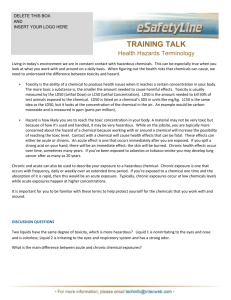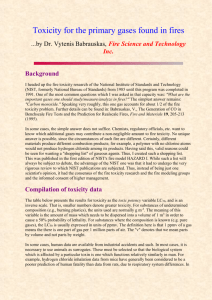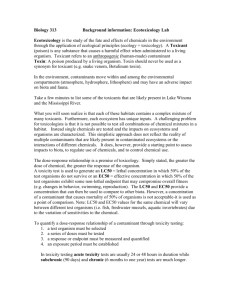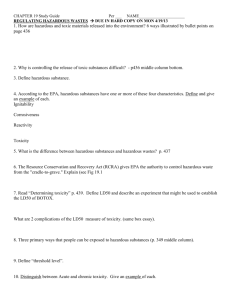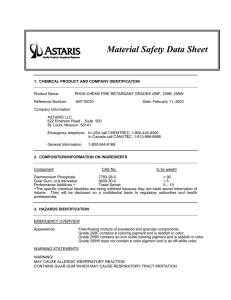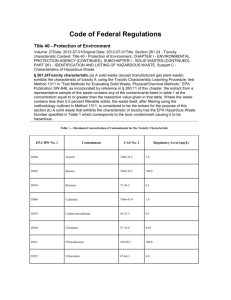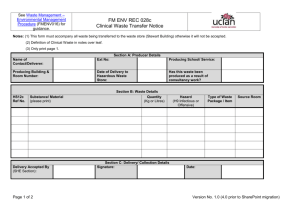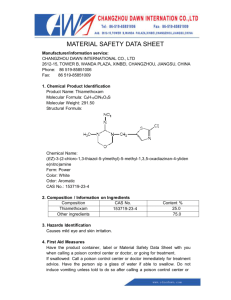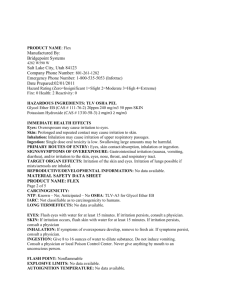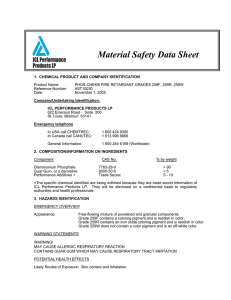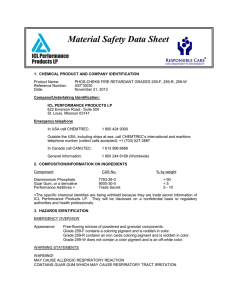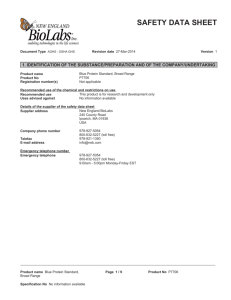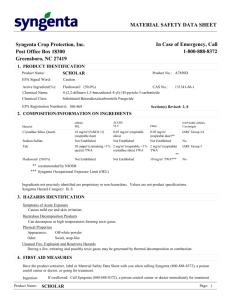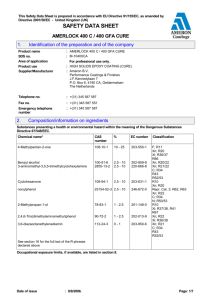MATERIAL SAFETY DATA SHEET
advertisement
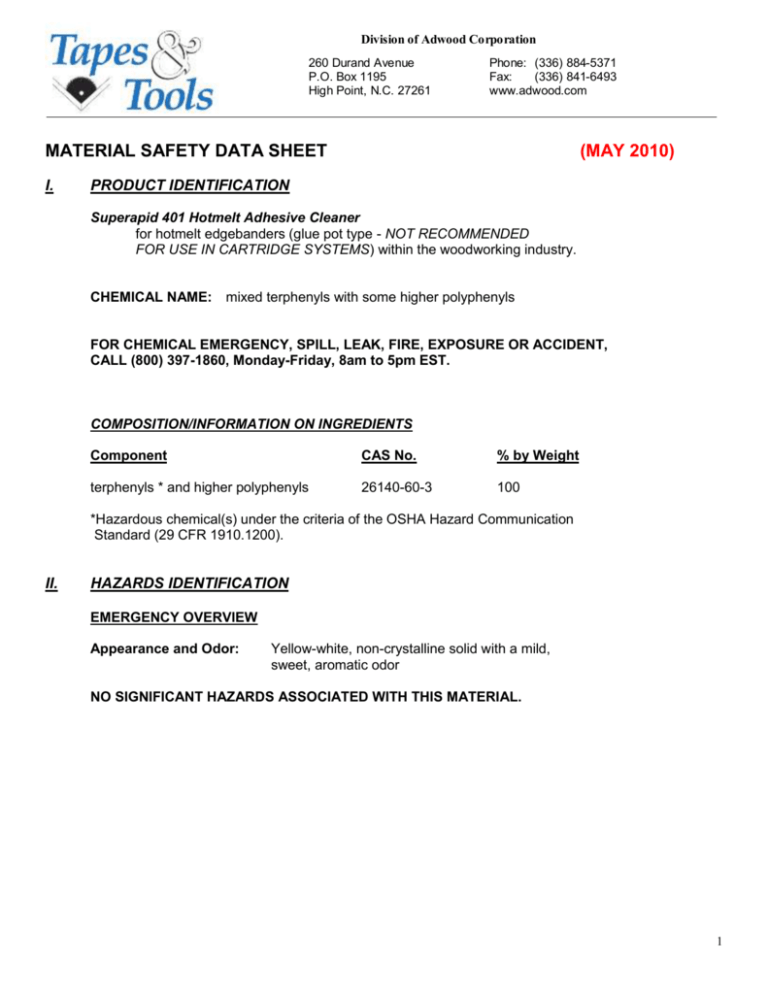
Division of Adwood Corporation 260 Durand Avenue P.O. Box 1195 High Point, N.C. 27261 Phone: (336) 884-5371 Fax: (336) 841-6493 www.adwood.com MATERIAL SAFETY DATA SHEET I. (MAY 2010) PRODUCT IDENTIFICATION Superapid 401 Hotmelt Adhesive Cleaner for hotmelt edgebanders (glue pot type - NOT RECOMMENDED FOR USE IN CARTRIDGE SYSTEMS) within the woodworking industry. CHEMICAL NAME: mixed terphenyls with some higher polyphenyls FOR CHEMICAL EMERGENCY, SPILL, LEAK, FIRE, EXPOSURE OR ACCIDENT, CALL (800) 397-1860, Monday-Friday, 8am to 5pm EST. COMPOSITION/INFORMATION ON INGREDIENTS Component CAS No. % by Weight terphenyls * and higher polyphenyls 26140-60-3 100 *Hazardous chemical(s) under the criteria of the OSHA Hazard Communication Standard (29 CFR 1910.1200). II. HAZARDS IDENTIFICATION EMERGENCY OVERVIEW Appearance and Odor: Yellow-white, non-crystalline solid with a mild, sweet, aromatic odor NO SIGNIFICANT HAZARDS ASSOCIATED WITH THIS MATERIAL. 1 Division of Adwood Corporation 260 Durand Avenue P.O. Box 1195 High Point, N.C. 27261 Phone: (336) 884-5371 Fax: (336) 841-6493 www.adwood.com HEALTH HAZARD DATA Primary routes of entry: Eye Contact: Inhalation & skin. No more than slightly irritating based on toxicity studies. Skin Contact: No more than slightly irritating based on toxicity studies. Inhalation: No more than slightly toxic if inhaled based on toxicity studies. Ingestion: No more than slightly toxic based on toxicity tests. No significant adverse health effects are expected to develop if only small amounts (less than a mouthful) are swallowed. Refer to Section 8 for toxicological information. EMERGENCY & FIRST AID PROCEDURES: EYES: In case of contact, immediately flush with plenty of low pressure water for at least 15 minutes. Remove any contact lenses to ensure thorough flushing. Call a physician. SKIN: INHALATION: INGESTION: NOTE TO PHYSICIAN: III. Wash with soap and running water. Remove to fresh air. Treat any irritation symptomatically. If swallowed, do NOT induce vomiting. Call a physician. No specific antidote. Supportive care. Treatment based on judgment of the physician in response to reactions of the patient. FIRE HAZARD DATA Flash Point: 196oC (385oF) Method: Pensky-Martens Autoignition temperature: Greater than 1000oF Method: ASTM D-2155 Flammable Limits in Air: LEL - (% by volume) 1% (estimated) UEL - (% by volume) 7% (estimated) Extinguishing Media: In case of fire, use water spray (fog), dry chemical, foam, or carbon dioxide Special firefighting procedures: Firefighters and others exposed to products of combustion, should wear full protective clothing, including a self-contained breathing apparatus. Thoroughly decontaminate equipment after use. Unusual fire & explosion hazards: None 2 Division of Adwood Corporation 260 Durand Avenue P.O. Box 1195 High Point, N.C. 27261 IV. Phone: (336) 884-5371 Fax: (336) 841-6493 www.adwood.com SPILL & DISPOSAL PROCEDURES Steps to be taken if material is released or spilled: Sweep up spill. If molten, let solidify, then scrape and break up for reuse, if cleanliness of area permits.Note: Spilled material may cause slippery hazard. Waste disposal method: This material when discarded, may be a hazardous waste as defined by the Resource Conservation and Recovery Act (RCRA), 40 CFR261.24, due to its toxicity characteristic. EPA hazardous waste number D018, (benzene, 0.5mg/l). This material should be analyzed in accordance with Method 1311 Toxicity Characteristic Leaching Procedure (TCLP) and compared to the regulatory level. Dispose of in accordance with local, state, and federal regulations. Consult your attorney or appropriate regulatory officials for more information on such disposal. V. HANDLING & STORAGE HANDLE IN ACCORDANCE WITH GOOD INDUSTRIAL HYGIENE AND SAFETY PRACTICES. THESE PRACTICES INCLUDE AVOIDING UNNECESSARY EXPOSURE AND REMOVAL OF MATERIAL FROM EYES, SKIN & CLOTHING. Emptied container retains vapor and product residue. Observe all labeled safeguards until container is cleaned, reconditioned, or destroyed. VI. APPLICABLE CONTROL MEASURES Appropriate hygienic practices: Avoid contact with eyes, skin and clothing. Wash thoroughly after handling, and before eating, drinking or smoking. Personal protective equipment: Safety glasses / goggles Impervious gloves Protective apron Long Sleeves Avoid breathing dust and/or vapors. Use NIOSH/MSHA approved respiratory protection equipment when airborne exposure limits are exceeded. Consult respirator manufacturer to determine appropriate type equipment for given application. Observe respirator use limitations specified by NIOSH/MSHA or the manufacturer. Respiratory protection programs must comply with 29 CFR 1910.134. Work practices: Keep away from sparks and open flame. Eyewash fountains and safety showers should be easily accessible. 3 Division of Adwood Corporation 260 Durand Avenue P.O. Box 1195 High Point, N.C. 27261 Phone: (336) 884-5371 Fax: (336) 841-6493 www.adwood.com Handling & storage precautions: Store in a cool, dry area. Engineering controls: Adequate ventilation should be provided to keep mist and vapor concentrations below acceptable exposure limits. If practical, use local mechanical exhaust ventilation at sources of air contamination such as open process equipment. Protective measures during repair & maintenance: Eliminate sources of ignition. AIRBORNE EXPOSURE LIMITS: OSHA PEL: 5 mg/m3 (0.5ppm) ceiling ACGIH TLV: 5 mg/m3 (0.5ppm) ceiling VII. TYPICAL PHYSICAL & CHEMICAL CHARACTERISTICS Appearance: yellow-white, non-crystalline solid Odor: mild, sweet aromatic 364oC - 418oC = (687oF - 784oF) Boiling Point: Vapor Pressure @ 20oC: Not Applicable Vapor Density (Air = 1): 8 % Volatile (vol.): Not Determined Softening Point: 60oC (140oF) typical, completely liquid at 145oC (293oF) Solubility in Water: Negligible Specific Gravity: 1.13 typical pH: Not Applicable Evaporation Rate: Stability considerations: Not Applicable Stable Incompatibility with: Strong Oxidizers Hazardous decomposition products: No uniquely hazardous decomposition products are expected. If the product is burned, partial combustion produces carbon monoxide, smoke, soot, low molecular weight hydrocarbons - complete combustion produces carbon dioxide and water. Hazardous polymerization: Does Not Occur 4 Division of Adwood Corporation 260 Durand Avenue P.O. Box 1195 High Point, N.C. 27261 VIII. Phone: (336) 884-5371 Fax: (336) 841-6493 www.adwood.com TOXICOLOGICAL INFORMATION Data from laboratory studies are summarized below: Single exposure (acute) studies indicate: ORAL - Practically Nontoxic (Rat LD50 - >50,000 mg/kg) DERMAL - Practically Nontoxic (Rabbit LD50 - >12,500 mg/kg) EYE IRRITATION - Practically Nonirritating (Rabbit, 0.7/110.0) SKIN IRRITATION - Nonirritating (Rabbit, 24 hour exposure, 0.0/8.0) Superapid 401 has produced no genetic changes in a variety of standard tests using animal or bacterial cells. Components: Data from laboratory studies and from the scientific literature on terphenyls, major components of Superapid 401 which have been identified under the criteria of the OSHA Hazard Communication Standard (29 CFR 1910.1200): Terphenyls Ortho-, meta-, or para-terphenyl are slightly toxic to practically non-toxic by ingestion (rats). Ortho- and meta-terphenyl have been reported to cause death in rats at atmospheric concentrations of about 3.5mg/l. However, these deaths appeared to be caused by the physical properties of the material as opposed to toxicity. Following repeated exposures (30 days) to the terphenyls in their feed, reduced body weights and increased kidney and/or liver weights (ortho- and meta-isomers only) were noted in rats. No skin allergy was observed in guinea pigs following repeated injection of these materials within skin, but skin damage was noted at the injection site. IX. ECOLOGICAL INFORMATION The following data have been classified using the criteria adopted by the European Economic Community (EEC) for aquatic organism toxicity. A legend summarizing the classification scheme appears below: 48-hr EC50 Daphnia magna: >0.27 mg/l, Very Toxic 96-hr TL50 Bluegill sunfish: 13.3 ppm, Harmful 96-hr LC50 Rainbow trout: 27 mg/l, Harmful 96-hr LC50 Fathead minnow: >1000 mg/l, Practically Nontoxic 96-hr EC50 Algae (Chlorophyll a): 0.015 mg/l, Very Toxic 96-hr EC50 Algae (Cell number): 0.020 mg/l, Very Toxic 5 Division of Adwood Corporation 260 Durand Avenue P.O. Box 1195 High Point, N.C. 27261 Phone: (336) 884-5371 Fax: (336) 841-6493 www.adwood.com Legend for Aquatic Organism Toxicity (Journal of the European Communities, Annex VII A, Section 5.2.1): VALUES: CLASSIFICATIONS: LC50 or EC50 < 1.0 mg/L LC50 or EC50 > 1.0 mg/L and < 10 mg/L LC50 or EC50 > 10 mg/L < 100 mg/L LC50 or EC50 > 100 mg/L Toxic Harmful Practically Nontoxic Very Toxic Superapid 401 was evaluated in a 24-hour semi-continuous activated sludge test. Primary degradation was approximately 5% to 19%. Biodegradability was classed as slow to resistant. X. TRANSPORT INFORMATION The data provided in this section is for information only. Please apply the appropriate regulations to properly classify your shipment for transportation. This product is not hazardous under the applicable DOT, ICAO/IATA, or IMDG regulations. XI. REGULATORY INFORMATION TSCA Inventory: Listed SARA Hazard Notification: Hazard Categories Under Title III Rules (40 CFR 370): Section 313 Toxic Chemical(s): CERCLA Reportable Quantity: Not Applicable Not Applicable Not Applicable Refer to Section 1 for OSHA Hazardous Chemical(s) and Section 4 for RCRA classification. SEE ALSO: SUGGESTIONS FOR USE SHEET We cannot anticipate all conditions under which this information and our products, or the products of other manufacturers in combination with our products, may be used. We accept no responsibility for results obtained by the application of this information or the safety and suitability of our products, either alone or in combination with other products. Users are advised to make their own tests to determine the safety and suitability of each such product or product combination for their own purposes. Unless otherwise agreed in writing, we sell the products without warranty, and buyers and users assume all responsibility and liability for loss or damage arising from the handling and use of our products, whether used alone or in combination with other products. Although the information and recommendations set forth herein are presented in good faith and believed to be correct as of the date hereof, ADWOOD CORPORATION/TAPES & TOOLS makes no representations as to the completeness or accuracy thereof. Information is supplied upon the condition that the persons receiving same will make their own determination as to its suitability for their purposes prior to use. In no event will ADWOOD CORPORATION/TAPES & TOOLS be responsible for damages of any nature whatsoever resulting from the use of or reliance upon information. 6
